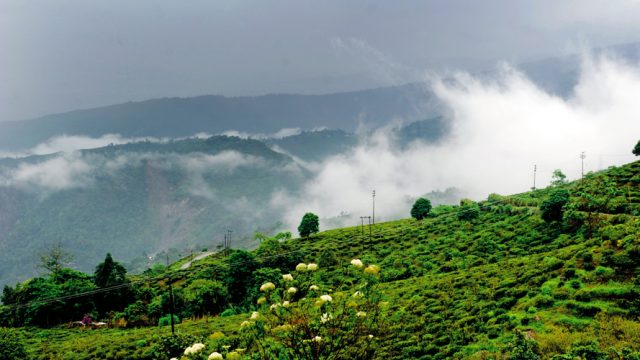Leaving the verdant valley, the landscape seems to change as rapidly as your driver changes his gears. Rivers rippling in the late after noon sunshine, vast tracts of tea gardens, lorries carrying fresh produce from the fields… all hurtle past in a blur as the car cleaves through the orchid-filled forests of Pankhabari. School kids, unmindful of the damp mist clinging to their hair, turn and wave as you rush past. Plunging down the side are wooded valleys so deep that all you can glimpse is the deep shadows indicating their plunge, over a thousand feet below. Nature plays a vital role in adding to the splendor of Kurseong. The road from Siliguri runs through thick forests, redolent with the aroma of tea from the gardens surrounding Kurseong. Kurseong was ceded to the British Empire by the king of Sikkim in 1835. Later, in 1880, colonial masters used the small hamlet as a sanatorium, where the sick could recuperate. More than a century later, Kurseong still continues to rejuvenate all who knock on its door.
Orientation
Kurseong is a small hill station, easily negotiated on foot. The Hill Cart and Tenzing Norgay roads run through the town. A bustling marketplace is Kur seong’s nerve centre, and the Darjeeling Himalayan Railway runs right through it.

Things to See & Do
Kurseong boasts of a number of reputed residential schools including Victoria School, Dow Hill School and Goethal’s Memorial. There are several soothing walks to be taken here, past the main school camp uses, through the leafy hillsides lined with wisteria and pale-blue hydrangea. An excellent choice is the walk to Nagri Spur, with its stunning views of the tea gardens and forests. Eagle’s Craig has a fabulous view of the Teesta River and the plains. You can also hike through the forests up the main ridge to Ghoom.
Kurseong Railway station
A sign outside Kurseong’s station says ‘Welcome to the most tourist-friendly Hill Railway Station’. The railway, a British legacy and now a UNESCO World Heri tage Site, is famous for its Toy Train which runs between Siliguri Junction and Darjeeling via Kurseong. An archive on the railway can be viewed inside.
Entry ₹10
Eagle’s Craig
This spot, perched on a cliff 1km from the railway station, is ideal for a sweeping view of the surrounding mountains, picturesque hamlets and lush green slopes around Kurseong. You will also get a panoramic view of Siliguri at night, dotted with bright lights in the distance. The sunsets seen from Eagle’s Craig are unfor gettable. There’s a cafeteria, a watch tower, a flower garden and Kurseong’s water reservoir here. Within the garden is Shahid Smarak, a concrete altar topped by a khukri. It was built by the Darjeeling Gorkha Hill Council as tribute to the lives lost in the agitation of 1988.
Dow Hill Deer Park
The Deer Park in Dow Hill, 4km from the town, was named for the large number of deer found in the area, though there are fewer now. If you are lucky, you might catch a glimpse of the animal. Venturing outside the park and into the forest is prohibited. The Forest Museum is also located in Dow Hill. It will tell you about the other animals that inhabit the forest here.
Timings 10.00am–5.00pm
St Mary’s Hill
A 4-km walk through damp woods brings you to St John’s Church on this secluded forested hill. The grotto, which houses a statue of Virgin Mary, is located in beautiful surroundings that also serve as a viewpoint. Devotees light candles here. Ironically, it’s also frequented by young couples for the seclusion it offers.
Giddhapahar
This hill, 3km from Kurseong, holds a Devi Temple which sees crowds descend for a big fair around Ramnavami. Also located here is the Netaji Museum, where Netaji Subhas Chandra Bose was interned by the British, and where he wrote the famous presidential speech for the Haripura Congress during the freedom movement. His belongings have been carefully preserved.
Timings 10.00am–5.00pm
Ambotia
Ambotia Shiv Mandir, 5km from Kurseong, is situated amidst orange orchards near the Ambotia Tea Estate. The Ambotia landside here drops 3,280ft to the River Balasan far below, and is 1.5kmwide.
Bagora
Bagora is also called Zero Point because it is the place with the highest elevation in Kurseong. So come here for some more fabulous views. This is where Kurseong’s Indian Air Force base is located.
Where to Stay
Cochrane Place (Cell: 09932035660; Tariff: ₹3,000–5,700), on the Pankhabari Road, is the fanciest. It has 31 rooms, a restaurant, a café, a souvenir shop and a wellness centre. Cochrane Place arranges many sightseeing trips in Kurseong and to the tea estates in its vicinity. It also provides Internet and gaming facilities. WBTDC’s Kurseong Tourist Lodge (Tel: 2345608; Tariff: ₹1,600–1,800) offers 16 double rooms, a bar and a restaurant. The rooms are comfortable. Another option is The Amarjit Hotel (Cell: 09832745678; Tariff: ₹2,000–3,000) with 10 rooms, a restaurant and a bar.
Where to Eat
There are several roadside eating joints around Kurseong Railway Station that should not be missed. Just behind the station is a board announcing ‘Gorkha Bansa Ghar Authentic Gorkha cuisine’, where you can try Gorkha or Nepali food. Maya Restau rant has good Chinese and Thai food. Amarjit Bar and Restaurant is popular for north Indian fare. Shyam’s is good for vegetarian fare. Try the Anglo-Indian cuisine at Cochrane Place’s restaurant. Delhi Darbar is a sweet shop near the railway station. The cafeteria at the Tourist Lodge has hot chai, momos and pizza.




